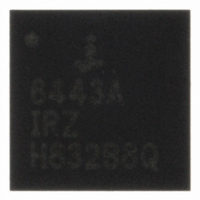ISL6443AIRZ Intersil, ISL6443AIRZ Datasheet - Page 15

ISL6443AIRZ
Manufacturer Part Number
ISL6443AIRZ
Description
IC CTRLR SGL/STEP DOWN PWM 28QFN
Manufacturer
Intersil
Datasheet
1.ISL6443AIRZ.pdf
(19 pages)
Specifications of ISL6443AIRZ
Applications
Power Supplies
Current - Supply
2mA
Voltage - Supply
5.6 V ~ 24 V
Operating Temperature
-40°C ~ 85°C
Mounting Type
Surface Mount
Package / Case
28-QFN
Rohs Compliant
YES
Lead Free Status / RoHS Status
Lead free / RoHS Compliant
Available stocks
Company
Part Number
Manufacturer
Quantity
Price
Company:
Part Number:
ISL6443AIRZ
Manufacturer:
Intersil
Quantity:
20
bypass capacitor may be placed across the base-to-emitter
resistor. This bypass capacitor, in addition to the transistor’s
input capacitor, could bring in a second pole that will
destabilize the linear regulator. Therefore, the stability
requirements determine the maximum base-to-emitter
capacitance.
Layout Guidelines
Careful attention to layout requirements is necessary for
successful implementation of a ISL6443A based DC/DC
converter. The ISL6443A switches at a very high frequency
and therefore the switching times are very short. At these
switching frequencies, even the shortest trace has
significant impedance. Also the peak gate drive current rises
significantly in extremely short time. Transition speed of the
current from one device to another causes voltage spikes
across the interconnecting impedances and parasitic circuit
elements. These voltage spikes can degrade efficiency,
generate EMI, increase device overvoltage stress and
ringing. Careful component selection and proper PC board
layout minimizes the magnitude of these voltage spikes.
There are two sets of critical components in a DC/DC
converter using the ISL6443A. The switching power
components and the small signal components. The
switching power components are the most critical from a
layout point of view because they switch a large amount of
energy so they tend to generate a large amount of noise.
The critical small signal components are those connected to
sensitive nodes or those supplying critical bias currents. A
multi-layer printed circuit board is recommended.
Layout Considerations
1. The Input capacitors, Upper FET, Lower FET, Inductor
2. Use separate ground planes for power ground and small
3. The loop formed by Input capacitor, the top FET and the
4. Ensure the current paths from the input capacitor to the
5. Place The PWM controller IC close to lower FET. The
6. Place VCC_5V bypass capacitor very close to VCC_5V
and Output capacitor should be placed first. Isolate these
power components on the topside of the board with their
ground terminals adjacent to one another. Place the input
high frequency decoupling ceramic capacitor very close
to the MOSFETs.
signal ground. Connect the SGND and PGND together
close to the IC. Do not connect them together anywhere
else.
bottom FET must be kept as small as possible.
MOSFET, to the output inductor and output capacitor are
as short as possible with maximum allowable trace
widths.
LGATE connection should be short and wide. The IC can
be best placed over a quiet ground area. Avoid switching
ground loop current in this area.
pin of the IC and connect its ground to the PGND plane.
15
ISL6443A
10. Route all high speed switching nodes away from the
11. Create a separate small analog ground plane near the IC.
12. Ensure the feedback connection to the output capacitor is
Component Selection Guidelines
MOSFET Considerations
The logic level MOSFETs are chosen for optimum efficiency
given the potentially wide input voltage range and output
power requirements. Two N-Channel MOSFETs are used in
each of the synchronous-rectified buck converters for the
PWM1 and PWM2 outputs. These MOSFETs should be
selected based upon r
and thermal management considerations.
The power dissipation includes two loss components;
conduction loss and switching loss. These losses are
distributed between the upper and lower MOSFETs according
to duty cycle (see Equations 10 and 11). The conduction
losses are the main component of power dissipation for the
lower MOSFETs. Only the upper MOSFET has significant
switching losses, since the lower device turns on and off into
near zero voltage. Equations 10 and 11 assume linear
voltage-current transitions and do not model power loss due
to the reverse-recovery of the lower MOSFET’s body diode.
A large gate-charge increases the switching time, t
which increases the upper MOSFET switching losses.
Ensure that both MOSFETs are within their maximum
junction temperature at high ambient temperature by
P
P
7. Place the gate drive components BOOT diode and BOOT
8. The output capacitors should be placed as close to the
9. Use copper filled polygons or wide but short trace to
LOWER
UPPER
capacitors together near controller IC
load as possible. Use short wide copper regions to
connect output capacitors to load to avoid inductance and
resistances.
connect the junction of upper FET, lower FET and output
inductor. Also keep the PHASE node connection to the IC
short. It is unnecessary to oversize the copper islands for
PHASE node. Since the phase nodes are subjected to
very high dv/dt voltages, the stray capacitor formed
between these islands and the surrounding circuitry will
tend to couple switching noise.
control circuitry.
Connect the SGND pin to this plane. All small signal
grounding paths, including feedback resistors, current
limit setting resistors, and SYNC/SDx pull-down resistors
should be connected to this SGND plane.
short and direct.
=
=
(
-------------------------------------------------------------- -
(
------------------------------------------------------------------------------ -
I
I
O
O
2
2
) r
) r
(
(
DS ON
DS ON
(
V
(
IN
DS(ON)
V
)
)
IN
) V
) V
(
(
OUT
IN
, gate supply requirements,
–
)
V
+
OUT
(
----------------------------------------------------------- -
I
O
)
) V
(
IN
) t
(
2
SW
) F
(
SW
June 2, 2008
SW
(EQ. 10)
(EQ. 11)
FN6600.2
,
)











